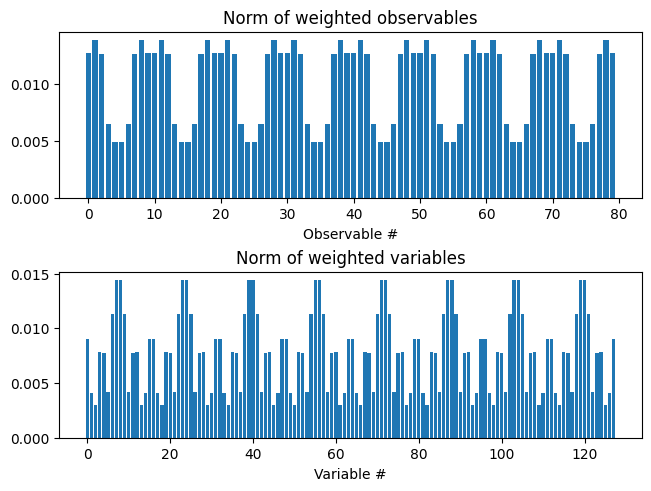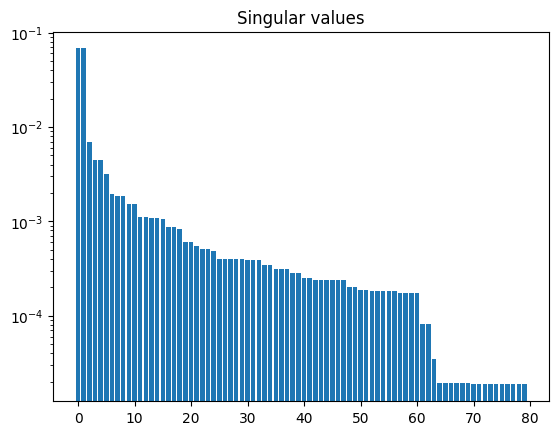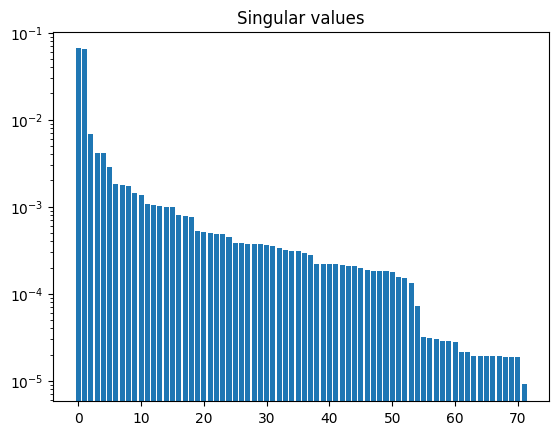Response matrices#
import at
import numpy as np
import math
from pathlib import Path
from importlib.resources import files, as_file
from timeit import timeit
from at.future import VariableList, RefptsVariable
with as_file(files("machine_data") / "hmba.mat") as path:
hmba_lattice = at.load_lattice(path)
for sx in hmba_lattice.select(at.Sextupole):
sx.KickAngle=[0,0]
hmba_lattice.enable_6d()
ring = hmba_lattice.repeat(8)
A ResponseMatrix object defines a general-purpose response matrix, based
on a VariableList of attributes which will be independently varied, and an
ObservableList of attributes which will be recorded for each
variable step.
ResponseMatrix objects can be combined with the “+” operator to define
combined responses. This concatenates the variables and the observables.
The module also defines two commonly used response matrices:
OrbitResponseMatrix for circular machines and
TrajectoryResponseMatrix for beam lines. Other matrices can be easily
defined by providing the desired Observables and Variables to the
ResponseMatrix base class.
General purpose response matrix#
Let’s take the horizontal displacements of all quadrupoles as variables:
variables = VariableList(RefptsVariable(ik, "dx", name=f"dx_{ik}", delta=.0001)
for ik in ring.get_uint32_index(at.Quadrupole))
Variable names are set to dx_nnnn where nnnn is the index of the quadrupole in the ring.
Let’s take the horizontal positions at all beam position monitors as observables:
observables = at.ObservableList([at.OrbitObservable(at.Monitor, axis='x')])
We have a single Observable named orbit[x] by default, with multiple values.
Instantiation#
resp_dx = at.ResponseMatrix(variables, observables, ring=ring)
At that point, the response matrix is empty.
Matrix Building#
A general purpose response matrix may be filled by several methods:
Direct assignment of an array to the
responseproperty. The shape of the array is checked,load()loads data from a file containing previously saved values or experimentally measured values,build()computes the matrix using tracking,For some specialized response matrices
build_analytical()is available.
resp_dx.build(use_mp=True)
Saving variables
Restoring variables
array([[ 16.94897864, -7.67022307, 2.50968594, ..., 5.3125638 ,
-5.57239476, 14.39501938],
[-10.6549627 , 3.59085167, -6.21666755, ..., -2.46632948,
8.42841189, -18.50171186],
[-10.99744814, 3.91741643, -5.60080281, ..., -2.73604877,
7.61448343, -17.01886021],
...,
[-17.0182359 , 7.61358522, -2.73824047, ..., -5.60018031,
3.92050176, -11.00305834],
[-18.50166601, 8.42772786, -2.46888914, ..., -6.21619686,
3.59444354, -10.66160249],
[ 14.38971545, -5.56943704, 5.31320321, ..., 2.50757509,
-7.6711941 , 16.94982252]], shape=(80, 128))
Matrix normalisation#
To be correctly inverted, the response matrix must be correctly normalised: the norms of its columns must be of the same order of magnitude, and similarly for the rows.
Normalisation is done by adjusting the weights \(w_v\) for the variables \(\mathbf{V}\) and \(w_o\) for the observables \(\mathbf{O}\). With \(\mathbf{R}\) the response matrix:
The weighted response matrix \(\mathbf{R}_w\) is:
The \(\mathbf{R}_w\) is dimensionless and should be normalised. This can be checked using:
check_norm()which prints the ratio of the maximum / minimum norms for variables and observables. These should be less than 10.
Both natural and weighted response matrices can be retrieved with the
response() and weighted_response()
properties.
resp_dx.plot_norm()
max/min Observables: 2.8352796928879394
max/min Variables: 4.768846272300127

Matrix pseudo-inversion#
The solve() method computes the singular values of the
weighted response matrix and its pseudo-inverse.
resp_dx.solve()
We can plot the singular values:
resp_dx.plot_singular_values()

After solving, correction is available, for instance with
correction_matrix()which returns the correction matrix (pseudo-inverse of the response matrix),get_correction()which returns a correction vector when given observed values,correct()which computes and optionally applies a correction for the providedLattice.
Exclusion of variables and observables#
Variables may be added to a set of excluded values, and similarly for observables. Excluding an item does not change the response matrix. The values are excluded from the pseudo-inversion of the response, possibly reducing the number of singular values. After inversion, the correction matrix is expanded to its original size by inserting zero lines and columns at the location of excluded items. This way:
error and correction vectors keep the same size independently of excluded values,
excluded error values are ignored,
excluded corrections are set to zero.
Exclusion of variables#
Excluded variables are selected by their name or their index in the variable list:
resp_dx.exclude_vars(0, "dx_9", "dx_47", -1)
Where -1 refers to the last variable.
Exclusion of observables#
Observables are selected by their name or their index in the observable list. In addition, for
ElementObservable observables, we need to specify a refpts to identify which item
in the array will be excluded.
Let’s exclude all Monitors with name BPM_07:
resp_dx.exclude_obs(obsid="orbit[x]", refpts="BPM_07")
Or by using the observable index:
resp_dx.exclude_obs(obsid=0, refpts="BPM_07")
Or even, since there is a single observable and obsid defaults to 0:
resp_dx.exclude_obs(refpts="BPM_07")
After excluding items, the pseudo-inverse is discarded so one must recompute it again:
resp_dx.solve()
resp_dx.plot_singular_values()

There are now only 72 singular values instead of 80 (number of active monitors).
The excluded items can be retrieved with the excluded_obs and
excluded_vars properties:
print(resp_dx.excluded_obs)
print(resp_dx.excluded_vars)
{'orbit[x]': array([ 79, 200, 321, 442, 563, 684, 805, 926], dtype=uint32)}
['dx_5', 'dx_9', 'dx_47', 'dx_964']
The exclusion masks can be reset using reset_vars() and
reset_obs().
Orbit response matrix#
An OrbitResponseMatrix defines its observables as instances of
OrbitObservable and its variables as KickAngle attributes of elements.
Instantiation#
By default, the observables are all the Monitor elements, and the
variables are all the elements having a KickAngle attribute. This is equivalent to:
resp_v = at.OrbitResponseMatrix(ring, "v", bpmrefs = at.Monitor,
steerrefs = at.checkattr("KickAngle"))
The variable elements must have the KickAngle attribute used for correction.
It’s available for all magnets, though not present by default except in
Corrector magnets. For other magnets, the attribute should be
explicitly created.
There are options in OrbitResponseMatrix to include the RF frequency in the
variable list, and the sum of correction angles in the list of observables:
resp_h = at.OrbitResponseMatrix(ring, "h", cavrefs=at.RFCavity, steersum=True)
print(resp_h.shape)
(81, 49)
Matrix building#
OrbitResponseMatrix has a build_analytical() build method,
using formulas from [1].
resp_h.build_analytical()
array([[-8.54870374e+00, -1.81104969e+01, -1.21497454e+01, ...,
-2.85830326e+01, -1.60772960e+01, -5.75838151e-08],
[ 1.85290756e+01, 3.16574224e+01, 1.82799745e+01, ...,
1.90656557e+01, 8.85865108e+00, -2.68128309e-06],
[ 1.68213604e+01, 2.87634523e+01, 1.65301788e+01, ...,
1.94726063e+01, 9.44097149e+00, -2.44436213e-06],
...,
[ 8.84897619e+00, 1.90656922e+01, 1.29411619e+01, ...,
3.16578009e+01, 1.85390265e+01, -2.68138514e-06],
[-1.60775574e+01, -2.85833742e+01, -1.65903209e+01, ...,
-1.81113028e+01, -8.54900471e+00, -5.76356368e-08],
[ 1.00000000e+00, 1.00000000e+00, 1.00000000e+00, ...,
1.00000000e+00, 1.00000000e+00, 0.00000000e+00]],
shape=(81, 49))
Matrix normalisation#
This is critical when including the RF frequency response which is not commensurate with steerer responses. Similarly for rows, the sum of steerers is not commensurate with monitor readings.
By default, the normalisation is done automatically by adjusting the RF frequency step and the weight of the steerer sum based on an approximate analytical response matrix. Explicitly specifying the cavdelta and stsumweight prevents this automatic normalisation.
After building the response matrix, and before solving, normalisation may be applied
with the normalise() method. The default normalisation
gives a higher priority to RF response and steerer sum.
Trajectory response matrix#
A TrajectoryResponseMatrix defines its observables as instances of
TrajectoryObservable and its variables as KickAngle attributes of elements.
Instantiation#
By default, the observables are all the Monitor elements, and the
variables are all the elements having a KickAngle attribute. This is equivalent to:
resp_v = at.TrajectoryResponseMatrix(lattice, "v", bpmrefs = at.Monitor,
steerrefs = at.checkattr("KickAngle"))
The variable elements must have the KickAngle attribute used for correction.
It’s available for all magnets, though not present by default except in
Corrector magnets. For other magnets, the attribute should be
explicitly created.
resp_h = at.TrajectoryResponseMatrix(ring, "h")
print(resp_h.shape)
(80, 48)

